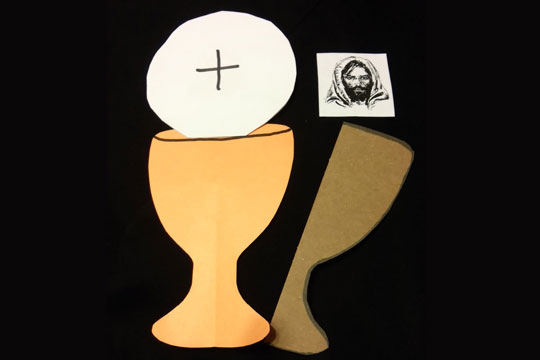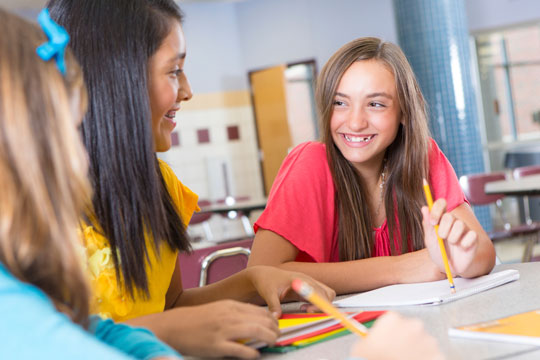
As we approach Holy Week, I like to focus my class on the events we recall on Palm Sunday and during the Triduum. That means that one of the chapters we cover during this time of year is the one on Eucharist and the Last Supper (Finding God, Grade 7, Chapter 16). I’m pleased to report that this was one of the most successful sessions we’ve had this year with good engagement from the young people.
We started by talking about how we prepare for celebrations, which got the young people interested right away. I did have to disappoint several who thought we were going to have a pizza party after our talk, but I could at least refer them to the pizza party that would be hosted by the youth group at the end of that week. I showed the class a scroll that I said was a special invitation to them and invited one of the kids to unroll the scroll to reveal a poster that said, “Jesus of Nazareth requests the honor of your presence at a dinner to be given in his honor.”
I then proceeded to ask the young people what they knew about a special celebration we read about in the Gospels—the Last Supper. I divided the class into groups of four and assigned each an area of the board. Their job was to list everything they knew about the Last Supper, and we would compare notes at the end to see which group knew the most. This competitive element is attractive for young people, so I like to use it in appropriate ways through the year. The exercise got the students out of their seats and gave me insight into their current knowledge on the topic.
I learned we had some work to do clarifying what happened at the Last Supper versus other mealtimes in Jesus’ life. For instance, some of the young people wrote things about turning water into wine or sharing fish. After this exercise, we took our seats and read from the Bible the story of the Last Supper according to Luke 22:14–20 and made the connection to the Liturgy of the Eucharist at Mass. The Art Print of da Vinci’s The Last Supper was displayed at this stage of the session, and several of the young people acknowledged having seen the artwork previously.
Then we looked at John’s version of the Last Supper and the washing of the disciples’ feet (13:1–15). I told the young people that we remember this event during the Holy Thursday liturgy and that the actions of Jesus showed the importance of humble service. At this point I flipped our Art Print easel to the previous chapter’s art, which shows Jesus washing Peter’s feet. We wanted to make the connection between coming together for a shared meal in the Eucharist and then being sent out to do service.
After a short prayer time with petitions under the heading “Jesus Fills Us,” we spent the last portion of our time together doing a simple craft project to reinforce the idea that Christ is present in the Eucharist. While the young people worked, we discussed some of the ideas from the chapter we hadn’t already covered. We cleaned up and I sent the group on their way, encouraging them to go to Mass and accept Christ’s invitation to Supper, with instructions to pay close attention to the words of the Mass that weekend.
How do you make the connections between Mass and the Last Supper clear for young people, especially as we approach Holy Week?





Denise – you have a very interactive and reflective lesson on the Last Supper and the Eucharist. I especially like the group activity on “list everything you know about x” – I will use that in some future lesson.
We just completed the lessons on the Paschal Mystery in our 6th Grade Salvation History curriculum. When we covered the Last Supper, I had the students focus on Jesus’ instruction – “Do this is remembrance of me” – what is Jesus’ message to us? We also discuss the connection to the Holy Mass in the story of Emmaus.
A variation on “how we prepare for celebrations” is a discussion developed by our DRE: I asked the students to name a celebrity or sports figure that they would love to meet. Then I asked how interested/excited they would be if that celebrity invited them and their family to dinner at a great restaurant, with the chance to talk with them, take pictures, get autographs – they all responded with enthusiasm. Then I asked what would they do if the dinner date/time conflicted with something else important in their schedules; they all said that they would ask their parents to rearrange things so that they could attend the special dinner. I then summarized Matthew 22 – the parable of the Wedding Feast, and asked what is the great “feast” that God invites us to? They all knew that it was Holy Mass and the Eucharist. I asked them to think about if they are giving as much priority to celebrating the feast of the Eucharist as they are to other events in their lives.
A great YouTube video to reflect on the presence of Christ in the Eucharist – do a search on “Lift the City Eucharistic Flash mob” – it highlights that Jesus is in every book of the Bible and the center of God’s Salvation plan, and also provides an opportunity to discuss the different reactions/responses of the passersby to the Eucharist (especially the responses of the adolescents and young adults).
Wishing you a very blessed Holy Week and Easter!
Mary, I like your DRE’s discussion starter. I’ll file that one for future use. A blessed Holy Week and Easter to you as well!
Denise, this is a masterful lesson, especially the strategy of having the kids come forward to share what they know (or think they know!) about the Last Supper. Nothing creates a teaching moment better than the realization that one’s knowledge of a subject is sorely lacking! Then, moving to the source – Scripture – to inform the students about the experience of the Last Supper, including the foot washing, demonstrates to the young people how crucial Scripture is to our faith and our understanding of our worship. Thanks for sharing!
You’re welcome, Joe.